Dynamic Analysis of Ecological Environment Quality Combined with Water Conservation Changes in National Key Ecological Function Areas in China
Abstract
:1. Introduction
2. Methodology
2.1. Study Areas
2.2. Data Sources
- (1)
- Data on key ecological function areas were produced using 1:1,000,000 national county-level data and the directory of NKEFAs in National Main Functional Areas Planning, 2010.
- (2)
- Raster data of 1 km land cover of 2000 and 2010 are from the Institute of Remote Sensing Application, Chinese Academy of Sciences.
- (3)
- Meteorological data (including precipitation, temperature, wind speed, etc.) of 683 meteorological stations around NKEFAs in 1999–2001 and 2009–2011 were obtained from the China meteorological data sharing service system (website: http://cdc.nmic.cn/home.do).
- (4)
- DEM data were provided by the Data Center for Resources and Environmental Sciences of Chinese Academy of Sciences (website: http://www.resdc.cn/Default.aspx).
- (5)
- The MODIS/Terra 16-day 250 m NDVI products MOD13Q1 (d001–d353) and eight-day 1 km LAI product MOD15A2 (d001–d361) in 2000 and 2010 were obtained from the NASA (website: http:e4ft01.cr.usgs.gov/).
- (6)
- Biomass field site data were collected from vegetation from the China Ecosystem Research Network (CERN) from the study sites, and consisted of 1146 records, including forest, shrub, grass, and farmland samples. Moreover, all species of shrub and parts of herb layers were from forest communities. The survey data were collected in 2004, when the vegetation was at the accumulative process of the growth stage. The information including vegetation type, actual fresh and dry weight (including branches, limbs, leaves, and roots), selected site, date, latitude, longitude, elevation, annual average temperature, and annual precipitation were recorded.
2.3. Research Methods
2.3.1. Transition Matrix for Land Cover Change Detection
2.3.2. Estimation of Biomass
2.3.3. Fractional Vegetation Cover
2.3.4. Water Conservation Amount
3. Results
3.1. Land Cover Change Analysis
3.2. Ecological Environment Quality Change Trends
3.3. Water Conservation Services Change Trends
4. Discussion
5. Conclusions
Acknowledgments
Author Contributions
Conflicts of Interest
Appendix A
| Land Cover Type | National Key Ecological Function Areas | ||||||||||||||
|---|---|---|---|---|---|---|---|---|---|---|---|---|---|---|---|
| XAL, AET, QLS, GN, REG, SJY, HLBR, YS, AEJ, TLM, ZXB [21,22,23] | CBS [21,22,23] | NL [21,22,23] | HTGY [21,22,23,24] | DBS [21,22,23] | SX [25,26,27,28,29,30] | GQD [21,22,23,31,32] | KEQ [21,22,23,33] | HSDK [21,22,23,34] | ZDN [21,22,23] | CD [21,22,23,35,36] | QB [21,22,23] | WLS [21,22,23,37,38] | SJPY [15,16,17,33] | HND [15,16,17] | |
| Evergreen Needleleaf Forest | 4.52 | 4.52 | 4.52 | 2.44 | 4.52 | 4.52 | 5.33 | 0.94 | 4.52 | 4.52 | 4.36 | 4.52 | 3.38 | 3.17 | 4.52 |
| Evergreen Broadleaf Forest | 4.65 | 4.65 | 4.65 | 4.65 | 4.65 | 3.15 | 5.35 | 4.65 | 4.65 | 4.65 | 4.94 | 4.65 | 1.07 | 4.65 | 4.65 |
| Deciduous Needleleaf Forest | 0.88 | 0.88 | 0.88 | 0.88 | 0.88 | 0.88 | 0.88 | 0.88 | 0.88 | 0.88 | 0.88 | 0.88 | 0.88 | 0.71 | 0.88 |
| Deciduous Broadleaf Forest | 2.70 | 2.70 | 2.70 | 3.20 | 2.70 | 2.25 | 2.70 | 0.76 | 2.70 | 2.70 | 4.89 | 2.70 | 4.21 | 2.70 | 2.70 |
| Mixed Forests | 3.52 | 3.52 | 3.52 | 6.77 | 3.52 | 5.03 | 3.52 | 0.78 | 3.52 | 3.52 | 3.75 | 3.52 | 2.67 | 3.52 | 3.52 |
| Shrub Forest | 4.17 | 4.18 | 4.22 | 4.17 | 4.19 | 4.67 | 6.16 | 0.31 | 4.17 | 4.23 | 9.06 | 4.20 | 1.83 | 4.18 | 4.26 |
| Meadow | 9.13 | 9.13 | 9.13 | 9.13 | 9.13 | 9.13 | 9.13 | 9.13 | 9.13 | 9.13 | 9.13 | 9.13 | 9.13 | 9.13 | 9.13 |
| Herbaceous steppe | 3.94 | 3.94 | 3.94 | 3.94 | 3.94 | 3.94 | 6.93 | 3.94 | 3.94 | 3.94 | 3.94 | 3.94 | 3.94 | 3.94 | 3.94 |
| Barren Grassland | 9.37 | 9.37 | 9.37 | 9.37 | 9.37 | 9.37 | 9.37 | 9.37 | 9.37 | 9.37 | 9.37 | 9.37 | 9.37 | 9.37 | 9.37 |
| Alpine meadow | 8.20 | 8.20 | 8.20 | 8.20 | 8.20 | 8.20 | 8.20 | 8.20 | 8.20 | 8.20 | 8.20 | 8.20 | 8.20 | 8.20 | 8.20 |
| alpine Steppe | 6.54 | 6.54 | 6.54 | 6.54 | 6.54 | 6.54 | 6.54 | 6.54 | 6.54 | 6.54 | 6.54 | 6.54 | 6.54 | -- | 6.54 |
| Shrub Grassland | -- | 4.06 | 4.08 | 4.06 | 4.06 | 4.07 | 4.08 | -- | 4.06 | 4.09 | 4.06 | 4.07 | 4.06 | -- | 4.10 |
| Paddy Field | 0 | 0 | 0 | 0 | 0 | 0 | 0 | 0 | 0 | 0 | 0 | 0 | 0 | 0 | 0 |
| Dryland Cropland | 22.95 | 22.95 | 22.95 | 22.95 | 22.95 | 9.40 | 7.20 | 22.95 | 22.95 | 22.95 | 22.95 | 22.95 | 6.42 | 22.95 | 22.95 |
| Settlements | 65 | 65 | 65 | 65 | 65 | 65 | 65 | 65 | 65 | 65 | 65 | 65 | 65 | 65 | 65 |
| Wetland and Water Bodies | 0 | 0 | 0 | 0 | 0 | 0 | 0 | 0 | 0 | 0 | 0 | 0 | 0 | 0 | 0 |
| Bare and Sandy Land | 32.88 | 32.88 | 32.88 | 32.88 | 32.88 | 32.88 | 5.58 | 32.88 | 18.16 | 32.88 | 32.88 | 32.88 | 32.88 | 32.88 | 32.88 |
References
- Liu, X.; Wang, Y.Q. Analysis of current research on key ecological function zones in China. World For. Res. 2014, 27, 93–96. (In Chinese) [Google Scholar]
- Li, G.P.; Li, X.; Wang, H.Z. Analysis of the ecological compensation of the transfer payment in the national key ecological function area. Mod. Econ. Sci. 2013, 35, 58–64. (In Chinese) [Google Scholar]
- Zhang, W.B.; Li, G.P. Dynamic incentive effect analysis of transfer payment in national key ecological function zone. China Popul. Resour. Environ. 2015, 25, 125–131. (In Chinese) [Google Scholar]
- Zhong, D.N. Research on the dilemma of financial transfer payment system in the construction of national key ecological function areas in China. J. Southwest Univ. Natly. (Humanit. Soc. Sci.) 2014, 35, 122–126. (In Chinese) [Google Scholar]
- Li, G.P.; Li, X. Allocation mechanism of national key ecological function area’s transfer payment. China Popul. Resour. Environ. 2014, 24, 124–130. (In Chinese) [Google Scholar]
- Li, G.P.; Liu, Q.; Zhang, W.B. Transfer payment system in the national key ecological function area and the ecological environmental quality—Empirical study based on the countryside data of Shaanxi Province. J. Xi’an Jiaotong Univ. (Soc. Sci.) 2014b, 34, 27–31. (In Chinese) [Google Scholar]
- Li, G.P.; Wang, H.Z.; Liu, Q. The dual objectives and performance evaluation of transfer payment in national key ecological function areas. J. Northwest Univ. (Philos. Soc. Sci. Ed.) 2014c, 44, 151–155. (In Chinese) [Google Scholar]
- Meng, Q.H. Analysis of ecological carrying capacity of national key ecological function areas in Hunshandake based on ecological footprints. For. Resour. Manag. 2014, 1, 127–130. (In Chinese) [Google Scholar]
- Fan, C. Analysis of the landscape pattern changes and ecological security of national key ecological function areas. Jiangxi Norm. Univ. Nanchang China, 2014. (In Chinese) [Google Scholar]
- He, W.J.; Qin, S.; An, M. The transfer payment policy shortcomings and improvement measures in National key ecological function areas—A case study of some counties and cities in Wuling Mountain Area (Hunan). Hubei Soc. Sci. 2015, 4, 67–72. (In Chinese) [Google Scholar]
- Finlayson, M.; Cruz, R.D.; Davidson, N.; Alder, J.; Cork, S.; de Groot, R.S.; Lévêque, C.; Milton, G.R.; Peterson, G.; Pritchard, D.; et al. Millennium Ecosystem Assessment: Ecosystem and Human Well-Being: Synthesis; Island Press: Washington, DC, USA, 2005. [Google Scholar]
- Li, W.H.; He, Y.T.; Yang, L.Y. A summary and perspective of forest vegetation impacts on water yield. J. Nat. Resour. 2001, 16, 398–406. (In Chinese) [Google Scholar]
- Zhang, B.; Li, W.H.; Xie, G.D.; Xiao, Y. Water conservation function and its measurement methods of forest ecosystem. Chin. J. Ecol. 2009, 28, 529–534. (In Chinese) [Google Scholar]
- Lü, X.Z. Study on the Effects of Forest Vegetation on Hydrological Process on Slope in Beijing Mountain Area; Beijing Forestry University: Beijing, China, 2013. (In Chinese) [Google Scholar]
- Sun, L.D.; Zhu, J.Z. Comprehensive Benefit Study and Evaluation of Soil and Water Conservation Forest System; Science Press: Beijing, China, 1995; pp. 362–377. [Google Scholar]
- Li, N.; Xie, G.D.; Zhang, C.S.; Xiao, Y.; Zhang, B.; Chen, W.H.; Sun, Y.Z.; Wang, S. Biomass resources distribution in the terrestrial ecosystem of China. Sustainability 2015, 7, 8548–8564. [Google Scholar] [CrossRef]
- Ventura, C.; Latino, D.A.R.S.; Martins, F. Comparison of multiple linear regressions and neural networks based QSAR models for the design of new antitubercular compounds. Eur. J. Med. Chem. 2013, 70, 831–845. [Google Scholar] [CrossRef] [PubMed]
- Xu, B.; Yang, X.C.; Tao, W.G.; Qin, Z.H.; Liu, H.Q.; Miao, J.M. Remote sensing monitoring upon the grass production in China. Acta Ecol. Sin. 2007, 27, 405–413. [Google Scholar] [CrossRef]
- Gómezbolea, A.; Llop, E.; Ariño, X.; Saizjimenez, C.; Bonazza, A.; Messina, P.; Sabbioni, C. Mapping the impact of climate change on biomass accumulation on stone. J. Cult. Heritage 2012, 13, 254–258. [Google Scholar] [CrossRef]
- Holben, B.N. Characteristics of maximum-value composite images from temporal AVHRR data. Int. J. Remote Sens. 1986, 7, 1417–1434. [Google Scholar] [CrossRef]
- Gong, S.H.; Xiao, Y.; Zheng, H.; Xiao, Y.; Ouyang, Z.Y. Spatial patterns of ecosystem water conservation in China and its impact factors analysis. Acta Ecol. Sin. 2017, 37, 2455–2462. [Google Scholar]
- Wang, S.Y. Study on the Characteristics of Slope Runoff and Sediment Yield in Dongtaigou Watershed of Huairou, Beijing; Beijing Forestry University: Beijing, China, 2011. (In Chinese) [Google Scholar]
- Wang, Q.; Zhang, X.X.; Wei, M.J.; Zhou, Y.W.; Li, P.; Bai, G.Y. Research summary of planning and design standards for storm water system in Beijing City. Water Wastewater Eng. 2011, 37, 34–39. (In Chinese) [Google Scholar]
- Zhang, X.M.; Sun, Z.F.; Zhang, X.P. Analysis on the function of different stand affecting runoff and sediment from rainstorm in Gullied Loess Hill of Jinxi. Sci. Soil Water Conserv. 2003, 1, 37–42. (In Chinese) [Google Scholar]
- Wen, X.S.; He, B.H.; Zhang, H.J.; He, F.; Miu, C.Y. An Analysis of the surface runoff characteristic and runoff yield of different woodlands in the Three Gorges Reservoir area. J. Southwest Univ. (Nat. Sci. Ed.) 2007, 29, 74–80. (In Chinese) [Google Scholar]
- Wang, X.R.; Wan, F.H.; Cui, H.X.; Pang, H.D.; Pan, L.; Tang, H. Located monitoring of soil and water conservation benefits of different reforestation patterns in Three Gorges Reservoir Region. Hubei For. Sci. Technol. 2014, 43, 1–4. (In Chinese) [Google Scholar]
- Shen, Y.K.; Wang, Y.J.; Qi, N.; Yang, X.M.; Li, Y.M.; Cheng, C. Effect of different vegetation types on runoff generation of slope land in Jinyun Mountains of Chongqing city. Bull. Soil Water Conserv. 2009, 29, 80–84. (In Chinese) [Google Scholar]
- Qi, S.L.; Zhang, H.J.; He, F.; Cheng, J.H. Effect of the vegetation types on runoff generation on slope land in Simian Mountain of Chongqing. Sci. Soil Water Conserv. 2006, 4, 33–38. (In Chinese) [Google Scholar]
- Wang, X.D.; Zhang, H.J.; Cheng, J.H.; Sun, Y.H. Characteristics of runoff on forest vegetation slopes in Three Gorges Area. Res. Soil Water Conserv. 2008, 15, 146–148. (In Chinese) [Google Scholar]
- Li, Y.M.; Wang, Y.J.; Chu, X.Y.; Cheng, C.; Qi, N. Effects of the rainfall factors on surface runoff of typical forest vegetations in Three Gorges Region. Res. Soil Water Conserv. 2009, 16, 244–249. [Google Scholar]
- Li, S.; Ren, H.D.; Yao, X.H.; Zhang, S.G.; Yang, S.; Lan, Y.Q.; Nong, M.D. Study on characteristics of runoff and nutrition loss between different vegetation land in typical karst rock desertification zone. J. Soil Water Conserv. 2009, 23, 1–6. (In Chinese) [Google Scholar]
- Ji, Q.F.; Zhang, X.Q.; Zhang, K.L.; Yang, Y.; Yang, G.X.; Gu, Z.K. Runoff and sediment characteristics of slope land in karst areas of Guizhou Province. Res. Soil Water Conserv. 2012, 19, 1–5. (In Chinese) [Google Scholar]
- Jiang, P.; Guo, F.; Luo, Y.C.; Wei, J.; Sun, X.W.; Wu, G. Water and soil conservation function of typical plantation forest ecosystems in semi-arid region of Western Liaoning Province. Chin. J. Appl. Ecol. 2007, 18, 2905–2909. (In Chinese) [Google Scholar]
- Zhao, H.Y.; Zhu, J.W.; Wang, W.H. Study on the runoff in forestbelt and grassland. J. Soil Water Conserv. 1994, 8, 56–61. (In Chinese) [Google Scholar]
- Liu, Z.Q. Study on the Forest Hydrology Ecological Function in Yunnan Plateau Mountain Jinshajiang Watershed; Kunming University of Science and Technology: Kunming, China, 2014. (In Chinese) [Google Scholar]
- Chen, Q.B.; Cun, Y.K.; Liu, Z.Q.; Wang, K.Q.; Wang, L.M. Study on runoff and sediment production on slope land of Western Plateau of Yunnan Province. Res. Soil Water Conserv. 2005, 12, 71–73. (In Chinese) [Google Scholar]
- Qi, L.H.; Zhang, X.D.; Zhou, J.X.; Wang, Z.Y. Runoff and sedimant characteristics of typical vegetation restoration patterns in a watershed, Wuling Mountain Region. Resour. Sci. 2008, 30, 709–716. (In Chinese) [Google Scholar]
- Zhou, J.; Zhang, X.D.; He, D.; Zhou, J.X.; Zhou, X.L.; Wang, Z.J. Characteristic of runoff and sediment yield and its influencing factors analysis on slope scale of small watershed in northwest Hunan. J. Soil Water Conserv. 2010, 24, 18–22. (In Chinese) [Google Scholar]
- Duan, W.B.; Liu, S.C. Analysis on runoff and sediment yields of water conservation forests in Lianhua Lake Reservoir Area. J. Soil Water Conserv. 2006, 20, 12–15. (In Chinese) [Google Scholar]
- Allen, R.G.; Pereira, L.S.; Raes, D.; Smith, M. Crop Evapotranspiration-Guidelines for Computing Crop Water Requirements-FAO Irrigation and Drainage Paper 56; FAO: Rome, Italy, 1998; Volume 300, pp. 1–15. [Google Scholar]
- Li, Y; Cao, Z; Long, H; Liu, Y.; Li, W. Dynamic analysis of ecological environment combined with land cover and NDVI changes and implications for sustainable urban–rural development: The case of Mu Us Sandy Land, China. J. Clean. Prod. 2017, 142, 697–715. [Google Scholar] [CrossRef]
- Huang, L.; Cao, W.; Wu, D.; Gong, G.L.; Zhao, G.S. Assessment on the changing conditions of ecosystems in key ecological function zones in China. Chin. J. Appl. Ecol. 2015, 26, 2758–2766. [Google Scholar]
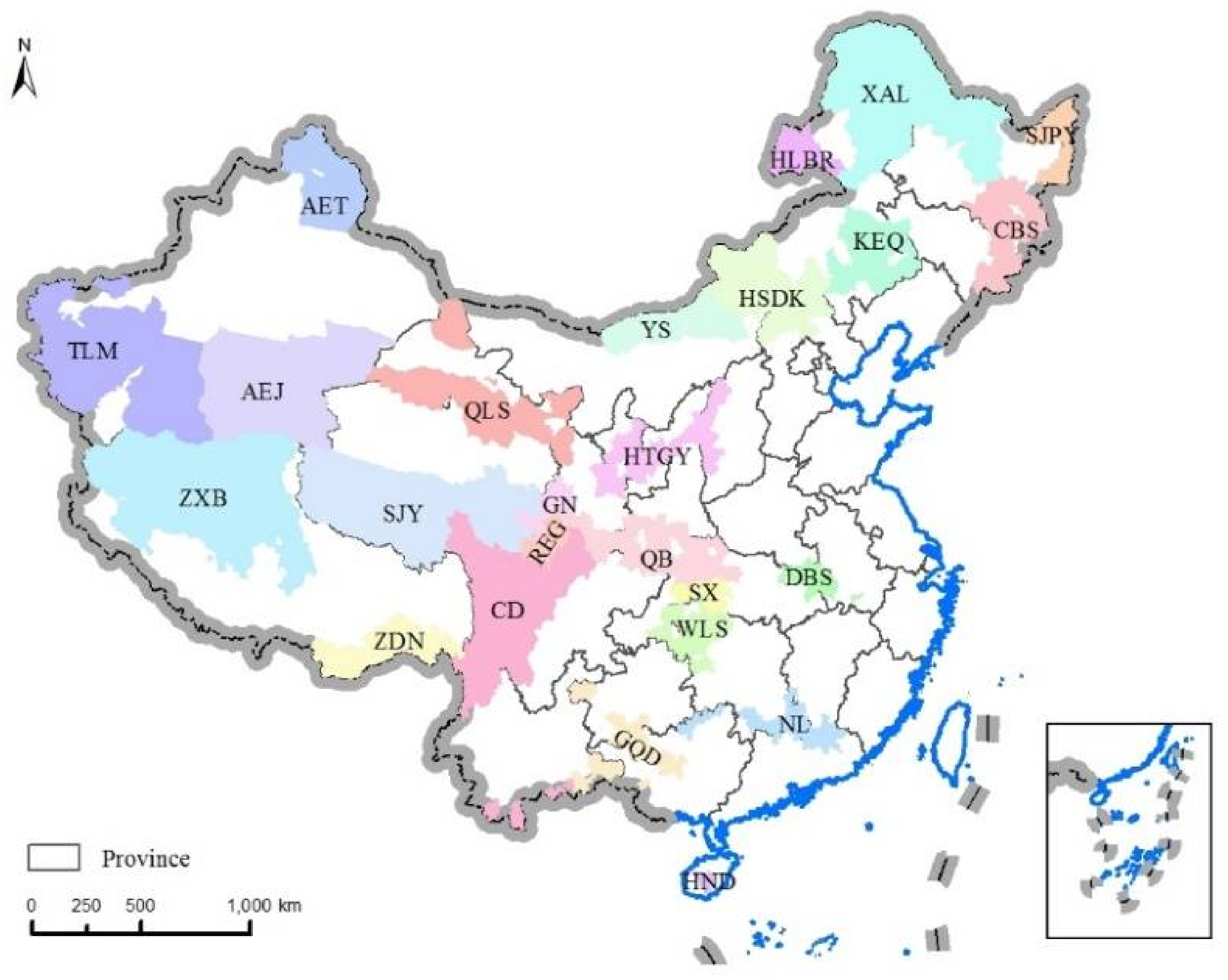
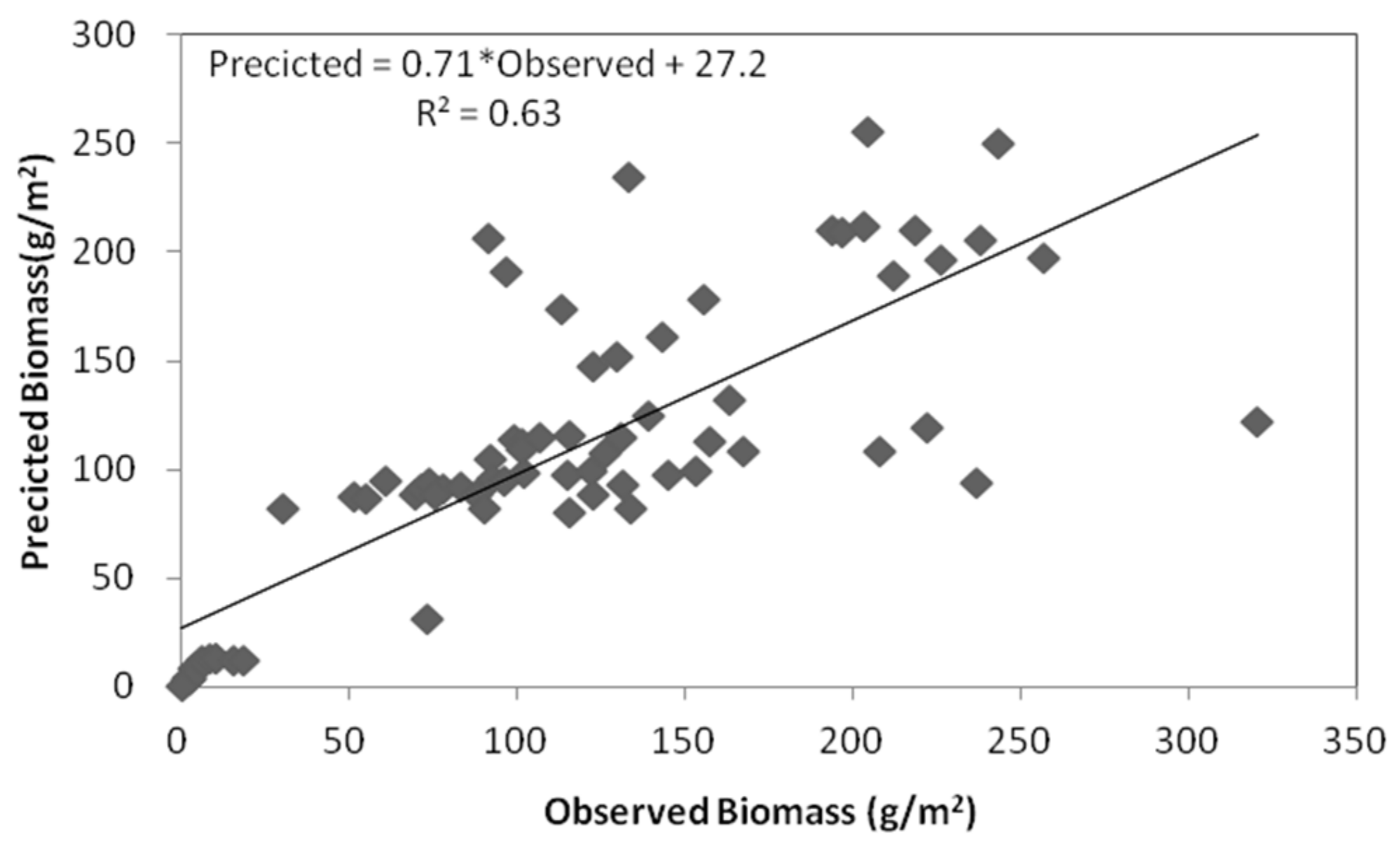

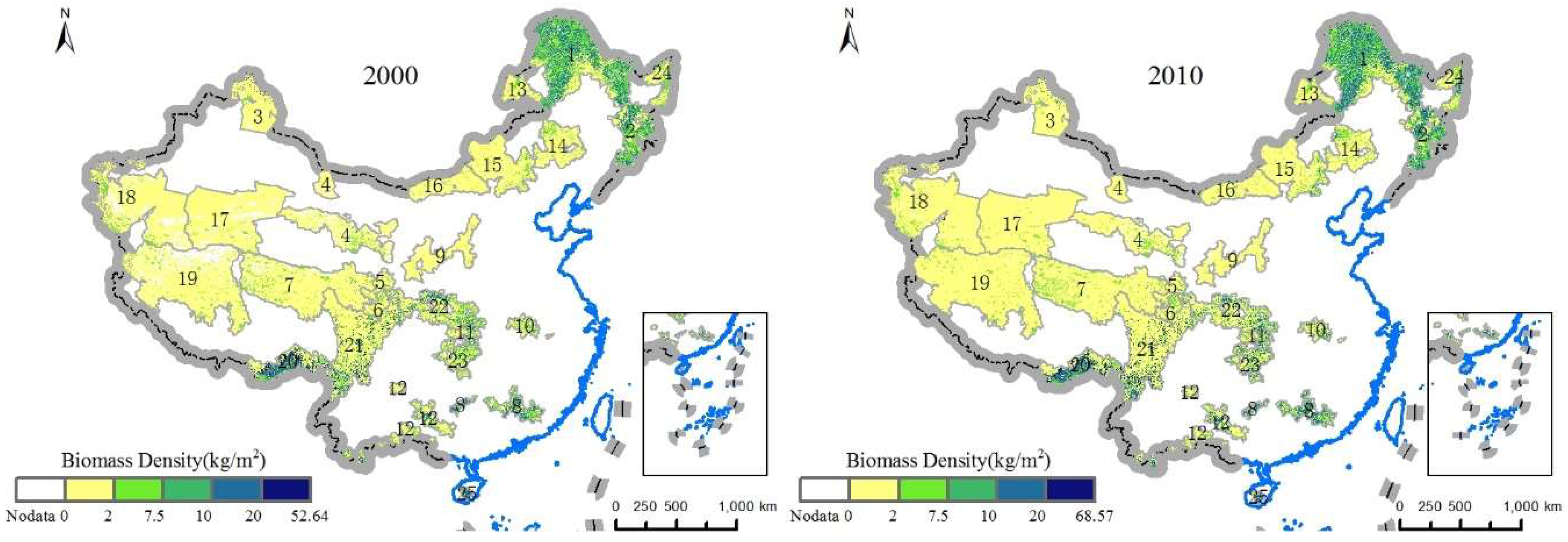
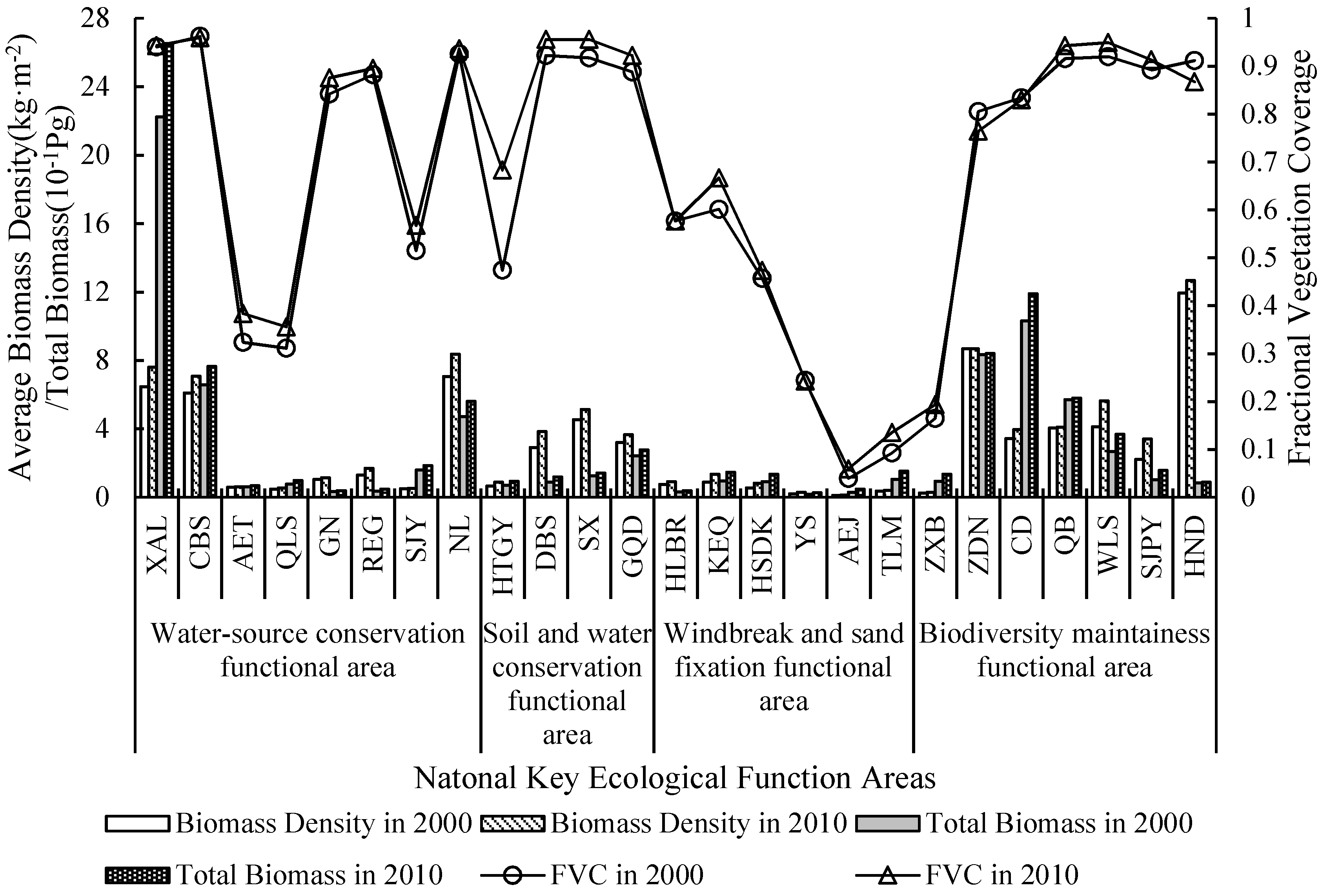
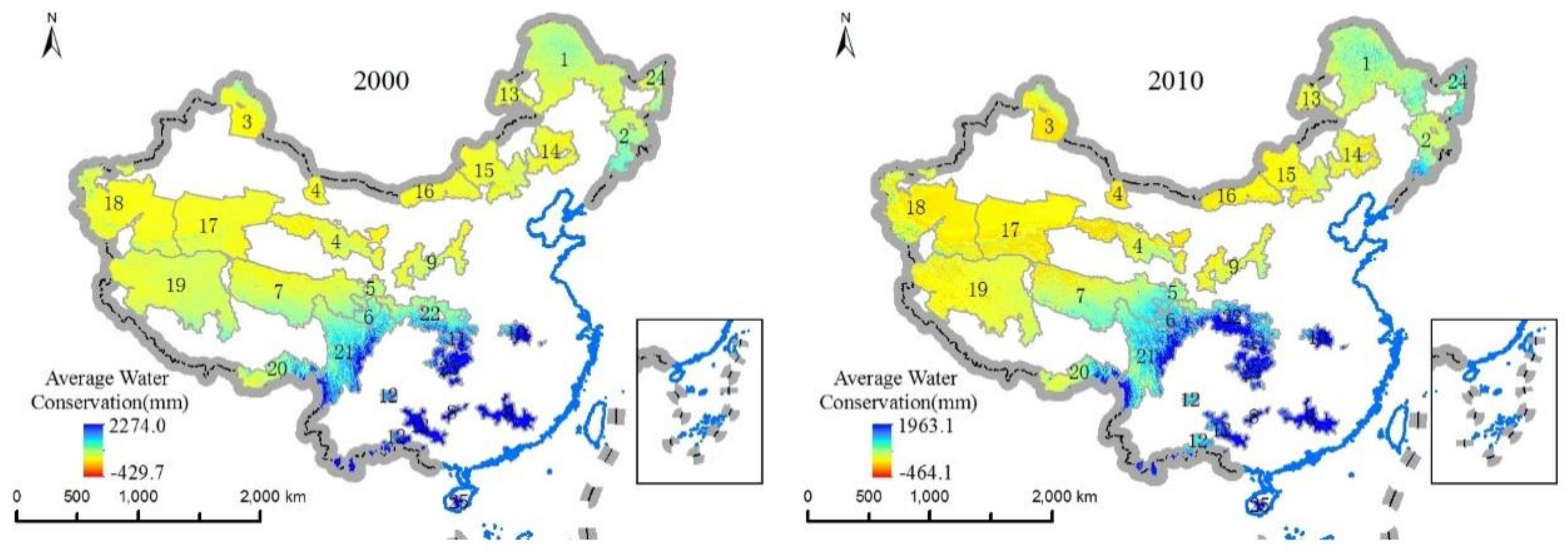

| Name of Ecological Function Area | Abbr. | Code | Name of Ecological Function Area | Abbr. | Code |
|---|---|---|---|---|---|
| Forest Ecological Function Area of the Great Khingan and Lesser Khingan Mountains | XAL | 1 | Ecological Function Area in the Horqin Grassland | KEQ | 14 |
| Forest Ecological Function Area on Changbai Mountain | CBS | 2 | Desertification Control Ecological Function Area in the Hunshandake Sandland | HSDK | 15 |
| Steppe Ecological Function Area on Altai Mountain | AET | 3 | Grassland Ecological Function Area in the Northern Foot of Yinshan Mountain | YS | 16 |
| Glacier and Water Conservation Ecological Function Area on Qilian Mountain | QLS | 4 | Desertification Control Ecological Function Area in the Alkin Grassland | AEJ | 17 |
| Significant Water Source Recharging Ecological Function Area of Southern Gansu Province | GN | 5 | Desertification Control Ecological Function Area of Tarim River Basin | TLM | 18 |
| Wetland Ecological Function Area of the Zoige County Grassland | REG | 6 | Desert Ecological Function Area on the Northwest Qiangtang Plateau | ZXB | 19 |
| Wetland Ecological Function Area of Sanjiangyuan National Nature Reserve | SJY | 7 | Forest Ecological Function Area on the Edge of the Plateau in the Southeast of Tibet | ZDN | 20 |
| Forest and Biodiversity Ecological Function Area on Nanling Mountain | NL | 8 | Forest and Biodiversity Ecological Function Area of Yunnan and Sichuan | CD | 21 |
| Hill and Ravine Soil Conservation Ecological Function Area on the Loess Plateau | HTGY | 9 | Biodiversity Ecological Function Area of Qinba Mountain | QB | 22 |
| Soil Conservation Ecological Function Area of Dabie Mountain | DBS | 10 | Biodiversity and Soil Conservation Ecological Function Area in Wuling Mountain | WLS | 23 |
| Soil Conservation Ecological Function Area of the Three Gorges Reservoir Region | SX | 11 | Wetland Ecological Function Area of the Three River Plain | SJPY | 24 |
| Stony Desertification Control Ecological Function Area of Guangxi-Guizhou-Yunnan | GQD | 12 | Tropical Rainforest Ecological Function Area in Mountain Areas in the Middle of Hai’nan Island | HND | 25 |
| Ecological Function Area on Hulun Buir Pasture Land | HLBR | 13 |
| Variables | Forest | Shrub | Grass | Farmland | ||||
|---|---|---|---|---|---|---|---|---|
| EN | DC | EB | DB | MF | ||||
| Elevation (E) | 0.40 ** | 0.10 | 0.08 | |||||
| Latitude (LAT) | −0.18 ** | −0.13 * | −0.46 ** | −0.44 ** | ||||
| Longitude (LON) | −0.51 * | |||||||
| Annual Precipitation (P) | 0.12 ** | 0.34 ** | ||||||
| Annual Average Temperature (T) | −0.07 | −0.10 | 0.19 ** | |||||
| LAI (LAI) | 0.59 ** | −0.59 ** | −0.78 ** | 0.55 ** | 0.52 * | 0.22 * | 0.38 ** | |
| NDVI (NDVI) | 0.94 ** | 0.16 ** | ||||||
| Grain dry weight (G) | 0.87 ** | |||||||
| Type | Linear Relationship | R2 | REE (%) |
|---|---|---|---|
| EN | Y1 = 0.097E + 12.88LAT + 0.07Pre + 18.14T + 14.35LAI + 779.38 | 0.52 | 32 |
| DC | Y2 = 19.78LAI − 49.14NDVI + 51.57 | 0.90 | 22 |
| EB | Y3 = 0.061E + 6.51T + 16.17LAI − 119.55 | 0.74 | 24 |
| DB | Y4 = 0.052E + 14.13LAT + 0.16Pre + 9.24T + 8.11LAI − 45.21NDVI − 686.68 | 0.49 | 9.4 |
| MF | Y5 = −11.37LON + 12.03LAI + 1292.63 | 0.68 | 21 |
| Shrub | Y6 = −0.59LAT + 0.15LAI + 21.94 | 0.27 | 1.5 |
| Grass | Y7 = −0.20LAT + 0.09LAI + 6.76 | 0.36 | 0.38 |
| Farmland | Y8 = 1.98G + 0.16 | 0.72 | - |
| Wetland | Y9 = 400 g/m2 | - | - |
| Desert | Y10 = 2 g/m2 | - | - |
| Land Cover Types | Cropland | Forest | Shrub | Grassland | Artificial Surface | Others |
|---|---|---|---|---|---|---|
| ω | 0.5 | 1.5 | 1 | 0.5 | 0.1 | 0.1 |
| 2000 | 2010 | Total (2000) | Loss | Net Gain in 2010 | Changes in 2010 | ||||||||
|---|---|---|---|---|---|---|---|---|---|---|---|---|---|
| Ecological Land | Non-Ecological Land | ||||||||||||
| WL | FoL | BL | GL | FaL | RS | US | SL | ||||||
| Ecological Land | WL | 4.404 | 0.000 | 0.001 | 0.029 | 0.023 | 0.000 | 0.002 | 0.011 | 4.47 | 0.07 | −0.01 | −0.32 |
| FoL | 0.006 | 18.441 | 0.021 | 0.036 | 0.023 | 0.001 | 0.004 | 0.000 | 18.53 | 0.09 | 0.05 | 0.26 | |
| BL | 0.002 | 0.038 | 4.678 | 0.013 | 0.006 | 0.000 | 0.001 | 0.000 | 4.74 | 0.06 | 0.01 | 0.19 | |
| GL | 0.024 | 0.056 | 0.035 | 40.491 | 0.146 | 0.002 | 0.004 | 0.074 | 40.83 | 0.34 | −0.13 | −0.32 | |
| Non-Ecological Land | FaL | 0.012 | 0.042 | 0.012 | 0.074 | 8.148 | 0.007 | 0.013 | 0.004 | 8.31 | 0.16 | 0.07 | 0.84 |
| RS | 0.000 | 0.000 | 0.000 | 0.000 | 0.000 | 0.263 | 0.000 | 0.000 | 0.26 | 0.00 | 0.01 | 3.24 | |
| US | 0.000 | 0.000 | 0.000 | 0.000 | 0.000 | 0.000 | 0.063 | 0.000 | 0.06 | 0.00 | 0.03 | 41.73 | |
| SL | 0.008 | 0.001 | 0.001 | 0.060 | 0.035 | 0.000 | 0.003 | 22.680 | 22.79 | 0.11 | −0.02 | −0.08 | |
| Total (2010) | 4.46 | 18.58 | 4.75 | 40.70 | 8.38 | 0.27 | 0.09 | 22.77 | 100.00 | 0.83 | |||
| Gain | 0.05 | 0.14 | 0.07 | 0.21 | 0.23 | 0.01 | 0.03 | 0.09 | 0.78 | ||||
| Type | Water-Source Conservation Functional Area | Soil and Water Conservation Functional Area | Windbreak and Sand Fixation Functional Area | Biodiversity Maintenance Functional Area |
|---|---|---|---|---|
| 1 | GN | GQD, HTGY, SX | YS | CD, QB, WLS |
| 2 | ZDN, ZXB | |||
| 3 | XAL, REG, CBS, SJY | DBS | HLBR, HSDK, KEQ | HND, NL, SJPY |
| 4 | QLS | AEJ | ||
| 5 | AET | TLM |
| Literature Sources | Total Water Conservation Amount (×108 m3) | Study Area | Method | Data |
|---|---|---|---|---|
| Gong et al., 2017 [21] | 12,224.33 | forest, shrub, grassland, garden, and wetland ecosystem in China | Water balance equation | Ecosystem type: extracted by Landsat TM Precipitation and temperature: China National Metrology Information Center(NMIC)/China Meteorological Administration(CMA) Actual evapotranspiration: The Land Processes Distributed Active Archive Center (LP DAAC), Institute of Geographic Sciences and Natural Resources Research (IGSNRR) |
| Huang et al., 2015 [42] | 1050.72 (in 2000) 1081.56 (in 2010) | eight water-source conservation functional area: XAL, CBS, AET, QLS, GN, REG, SJY, NL | Precipitation storage method (without considering the spatial variation effect of vegetation coverage on runoff reduction efficiency) | Land cover data: extracted by Landsat TM Precipitation: China Meteorological Administration(CMA) Other data: literature research |
| This study | 4674.98 (in 2000) 4048.51 (in 2010) | NKEFAs | Water balance equation | Land cover data: :Institute of Remote Sensing Application, Chinese Academy of Sciences Meteorological data: China Meteorological Administration(CMA) Other data: literature research |
| This study | 1050.72 (in 2000) 1081.56 (in 2010) | eight water-source conservation functional areas: XAL, CBS, AET, QLS, GN, REG, SJY, NL | Water balance equation | the same as above |
© 2018 by the authors. Licensee MDPI, Basel, Switzerland. This article is an open access article distributed under the terms and conditions of the Creative Commons Attribution (CC BY) license (http://creativecommons.org/licenses/by/4.0/).
Share and Cite
Xu, J.; Xie, G.; Xiao, Y.; Li, N.; Yu, F.; Pei, S.; Jiang, Y. Dynamic Analysis of Ecological Environment Quality Combined with Water Conservation Changes in National Key Ecological Function Areas in China. Sustainability 2018, 10, 1202. https://doi.org/10.3390/su10041202
Xu J, Xie G, Xiao Y, Li N, Yu F, Pei S, Jiang Y. Dynamic Analysis of Ecological Environment Quality Combined with Water Conservation Changes in National Key Ecological Function Areas in China. Sustainability. 2018; 10(4):1202. https://doi.org/10.3390/su10041202
Chicago/Turabian StyleXu, Jie, Gaodi Xie, Yu Xiao, Na Li, Fuqin Yu, Sha Pei, and Yuan Jiang. 2018. "Dynamic Analysis of Ecological Environment Quality Combined with Water Conservation Changes in National Key Ecological Function Areas in China" Sustainability 10, no. 4: 1202. https://doi.org/10.3390/su10041202





